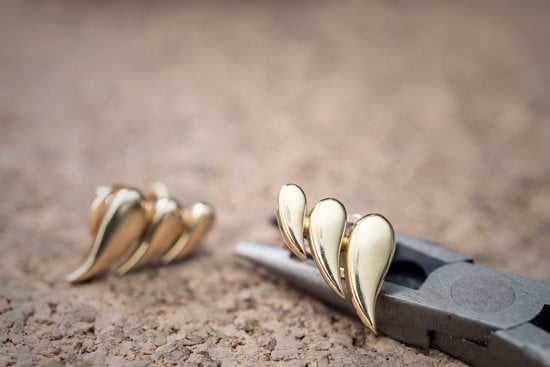Introduction
Soldering is a process of using a form of heat to join two or more pieces of metal together. When used in the construction of jewelry, it typically involves filling an area between two pieces of metal with a thin strip of solder. In order to melt and manipulate the solder, a butane torch is employed.
Butane torches are known for their portability and simplicity when compared to other types of torches like acetylene or propane as they require no tanks or pressurizing units. Utilizing a butane torch to solder jewelry allows an individual to work in more confined areas with far less risk than traditional soldering methods due to the smaller flame size and cooler temperatures produced by these torches.
There are three basic techniques involved when soldering jewelry with a butane torch: achieving proper temperature levels, correctly positioning the parts being joined, and ensuring that all gaps between the materials being joined are filled completely with solder. Additionally, one must first prepare their workspace prior to starting any soldering project by laying out all necessary tools such as metals files, fluxes, protective eye-wear, a variety of clamps and tongs, solder pick/whips, tweezers and additional items needed for specific tasks like cleaning metals with pickle solutions or reapplying patina after soldering is complete. Finally each item should be inspected closely before beginning any project; check for stress fractures that could result from too much or inadequate pressure when filing parts to be joined together together, chipping or discoloration which may indicate contamination with rust or foreign objects.
Preparation
To solder jewelry with a butane torch, you will need several tools and materials to ensure a successful result. The first of these is the butane torch itself – make sure it is suitable for soldering jewelry and that it has been tested to be free from leaks. You will also need flux, solder, pickle solution and tweezers. Other items you may require include pliers and wire cutters, pickle pot or container, spool holder and third-hand tool. You may additionally wish to use protective gloves with anti-heat properties or flame retardant tools. Finally, be sure to have appropriate ventilation when using a butane torch indoors – keep windows open or place the workspace near an open window.
Safety
Soldering with a butane torch is an excellent way to join two pieces of metal jewelry together, and it’s fairly easy to do. However, as with any soldering job, safety is of the utmost importance. Before beginning your work, here are some safety precautions you should take:
1. Wear the proper protective clothing. The most important piece of attire for any soldering session is Safety Goggles; these will protect your eyes from dangerous sparks and spatter of hot metal. Protective gloves are also recommended, as well as a face shield, long-sleeved shirt or apron to protect your skin and lungs from the heat of the torch.
2. Make sure to work in an adequate space that’s free from flammable surfaces and materials like wood, wallpaper, fabrics and paper scraps. You should also ensure the area is properly ventilated to minimize smoke inhalation; avoid working in small or crowded spaces.
3. Inspect all materials such as metals and torches before you begin each project; never use damaged items under any circumstances!
4. Read instructions on packaging or leaflets carefully and follow instructions for handling butane fuel responsibly; always store fuel in its proper container away from flames and sparks once finished with a project as fuels like butane are highly combustible if not handled properly!
5. Have a fire extinguisher at hand in case of emergency – make sure you know how to handle it properly so you can act efficiently if needed!
Process
1. Gather Your Tools: The main tool you will need is the butane torch. You will also need a soldering iron, safety glasses or goggles, flux, solder, tweezers and pickle solution to clean off fingerprints.
2. Clean Surfaces: Begin by thoroughly cleaning the surfaces that you intend to solder together with warm water and soap or jewelry cleaning solution. Allow them to dry before proceeding to the next step.
3. Prepare Materials: Place your pieces of metal into position for your desired design, securing them with lead-free tape if needed.
4. Apply Flux: Apply flux on all of the edges that will be soldered together using either a brush or a syringe, depending on which type of flux compound you are using. This will help create an airtight connection when heated with the wire solder later on in the process.
5. Heat Up The Butane Torch: Light up your butane torch and hold it 6-8 inches away from the pieces of metal being soldered together while adjusting the flame accordingly until you reach maximum heat intensity that is hot enough to melt the solder without damaging it in any way (around 500°F). Avoid direct contact with the flame as this can cause discoloration and tarnishing on your jewelry pieces over time when exposed to high temperatures repeatedly throughout its lifespan.
6. Solder Edges Together: Once heated correctly, use tweezers to pick up small amounts of wire solder then apply it onto both edges of where they meet and press down firmly until melted completely (take extra caution not to burn yourself).
7. Remove Excess Solder – When finished soldering each piece in place securely, remove any excess molten solder by dipping them in cold water and scrubbing with a brush if necessary for a smoother finish overall
8 . Clean Jewelry Pieces With Pickle Solution – Last but not least, once cooled down completely submerge your newly created jewelry masterpiece into a pickle solution for about 10 minutes or so and then rinse off under running water one last time – this should rid any final traces of fingerprint left behind during handling process before wearing or displaying proudly!
Troubleshooting
Soldering jewelry with a butane torch can be tricky at times. Following the right steps and troubleshooting common issues is essential to getting perfect results every time.
The most common issue when soldering is not having a hot enough flame. If the flame is too cool, it won’t provide adequate heat to make a good joint. To get the best heat, adjust the torch so that it creates a pointed flame with an even color across its length.
Another common issue is overheating. If solder flows in areas that are not supposed to flow, cool down the soldering area and wipe away any excess solder with a clean cloth to reduce any additional heating before continuing with your work.
Authentic silver or gold flux can cause unwanted bubbling during soldering which will likely ruin the piece if left unchecked. Never use sugary soda as flux or you will risk ruining your whole project! Be sure to choose properly designed flux for specific metals before beginning your work
Finishing
Achieving a professional-looking finish when soldering jewelry can be tricky. There are a multitude of techniques and tools available, but many jewelers favor using a butane torch. Butane torches generate high temperatures that allow the solder to quickly and effectively create strong bonds with metals, making them ideal for intricate projects like jewelry. Here are step-by-step tips for soldering jewelry with a butane torch:
1. Gather your materials: A butane torch, flux, solder and soldering pick, flux brush, safety glasses, metal clamps or alligator clips will be necessary.
2. Heat the metal: Holding your butane torch at an angle facing away from you, carefully heat the surface of the metal evenly until it brightens in color to indicate it’s sufficiently heated. Remove the flame from the metal every few seconds so you don’t overheat or damage delicate pieces. Be sure to angle your head away from any smoke that may appear as a result of heating particular metals such as copper or iron.
3. Apply Flux: Use your small artist brush to apply flux where needed to insure a strong bond between two separate surfaces when soldering them together– this primarily applies to doublet stones where two elements need to be bonded together
4. Place Solder: Once your metal is hot enough for solder, place the solder on top of the seam by holding it between two alligator clamps near both sides of the seam alternatively you can use your soldering pick depending on how intricate the piece is
5. Reheat Metal (optional): If you need additional heat while placing it in certain areas please reheat as needed as long as there isn’t any excess solder drawing towards itself which can happen when left with too much heat
6. Let Cool and Carefully Release Clamps/ Solder Pick: After each step let both pieces cool off before releasing the clamps and/or removing the pick—this will ensure that there isn’t any tearing or ruining of delicate details along he edges once everything has cooled down
7 Final Steps: Finally examine each joint and look for bridges or incomplete seams that may need additional attention; trim off unwanted excess by filing or grinding if necessary — you’re now ready to start setting faceted stones and making beautiful pieces of jewelry!
Conclusion
If you are serious about becoming a successful jewelry designer, then soldering with a butane torch should be an essential part of your craft. Utilizing this technique allows you to create intricate and beautiful pieces with much less effort than using traditional soldering techniques. The process is relatively simple and easy to learn, and it is also very affordable to do. The most important thing is to be patient while learning the technique – practice regularly until you have a good feel for how much heat you need, the right speed and angle at which to move the torch, and other important details specific to the types of material that will be bonded together. Once you’ve gotten comfortable with how to properly solder with a butane torch, it’s time to apply these new skills in your creativity and plan out designs for your jewelry pieces. Having mastery over such an effective and rewarding tool for jewelry design can lead to greater confidence in the quality of work produced by yourself or your team. And once you feel that sense of satisfaction from making something unique that expresses your creative vision, there’s no stopping what heights can be achieved through passionate design projects! With patience and dedication, soldering with a butane torch can take someone from aspiring jewelry maker to accomplished artisan crafting exquisite works valued by customers all over the world.

Welcome to my jewelry blog! My name is Sarah and I am the owner of this blog.
I love making jewelry and sharing my creations with others.
So whether you’re someone who loves wearing jewelry yourself or simply enjoys learning about it, be sure to check out my blog for insightful posts on everything related to this exciting topic!





